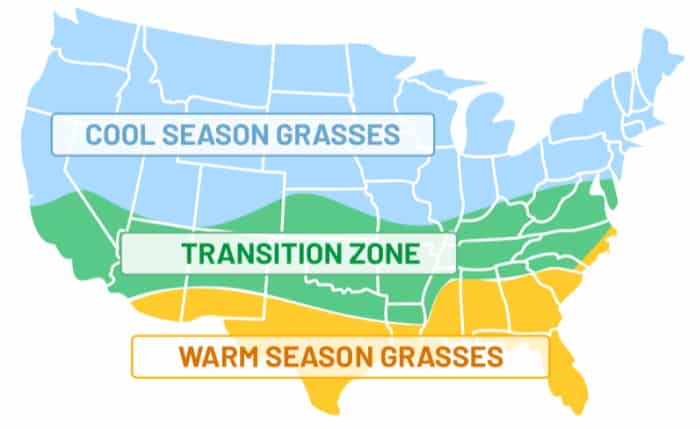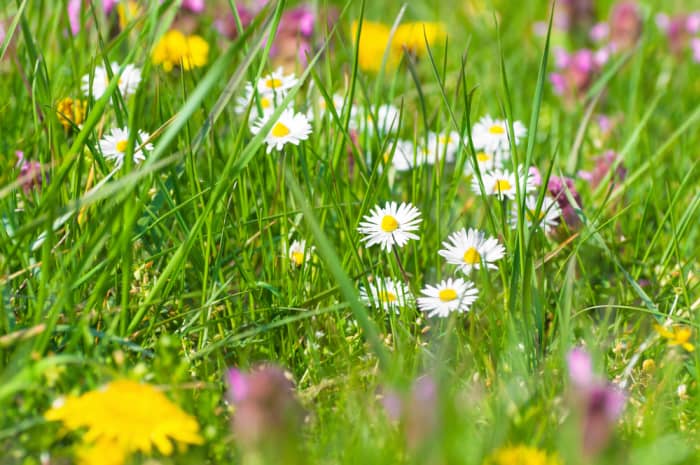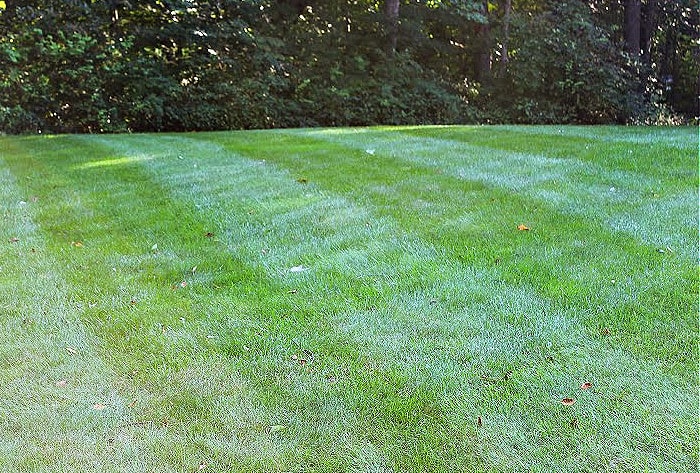Installing low maintenance grass types can save you a lot of time, money, and frustration.
For some homeowners, spending time trying to have the best lawn on the block is a fun challenge and a sense of pride. Others view lawn care as a nagging chore that wastes their time and money. And of course, others fall somewhere in the middle. If your someone looking to spend less time maintaining your lawn, there is good news. You can grow low maintenance grass that will save you time, money, and frustration, and best of all, you don’t have to make huge concessions aesthetically.
What Is Low Maintenance Grass
Simply put, low maintenance grass is grass that requires less inputs to maintain. For a low maintenance lawn, grass types are selected so they have a higher chance of flourishing in a region naturally. The key to having a low maintenance lawn is to select the grass types that do well in your region with little inputs, and avoid the grass types that require larger amounts of resources to flourish in that same reason. This environmental advantage reduces inputs such as water, fertilizer, herbicides, pesticides, and time spent mowing and maintaining a lawn.
Within the discussion of a ‘Low Maintenance Lawn’ it’s important to align your goals with reality. For example, you may see bags of seed labeled as ‘No Mow’ grass seed. The reality is even the No Mow seed mixes require mowing a couple of times a year, and sometimes as often as every 3 weeks. And if you’re looking to achieve a neater appearance, you’ll have to mow more frequently than that.
Conversely, you may be looking for something that’s almost completely hands off, in which case a ‘Bee Lawn’ seed mix might be a great choice. These mixes are usually a blend of grass and wild flowers. These mixes are great if you want to control erosion, feed pollinators, and enjoy the natural beauty of a landscape that requires less maintenance. Again though, it’s important to realize this type of mix might not be the best choice in every situation. For example your homeowners association might have strict rules against installing a bee lawn.
Whether you’re looking for a lower maintenance lawn that still looks good, or a full out bee lawn that requires little to no maintenance, you have to consider the region you’re in. Look at the map below to determine which region you’re in (Cool Season, Transition, or Warm Season), and from there we’ll break down the different seed types and which region they will thrive in.

Low Maintenance Grass Types
1. Fine Fescue (For northern regions down to the transition zone)
Of all the regions in the map above, it’s the Cool Season Grass regions that have the best options for a low maintenance lawn that still looks good. That’s because in these regions fine fescues thrive. Fine fescues are the key to a low maintenance lawn. There are 5 main types of fine fescue: Slender Creeping Red Fescue, Strong Creeping Red Fescue, Chewings Fescue, Hard Fescue, and Sheep Fescue. These 5 fescues are great low maintenance grass types for a variety of reasons:
- They are slow growers which means less mowing.
- Deep root systems makes them withstand periods of drought and overall they require less water.
- They do well in shade and sun.
- Require less nitrogen (less fertilizer needed).
- Generally more disease resistant.
While these 5 types of fine fescues have some distinct individual characteristics, they are usually mixed together so you get a lawn that is a mix of the different fescues. This variation will let nature dictate which varieties will become dominant in your lawn, rather than trying to force the success of one seed type. Most fine fescue mixes contain 3 to all 5 of the different fescue types. Fine fescue is a great choice for much of the northern states as highlighted in the blue area in the map above. It can also be used in the upper portions of the transition zone highlighted in green.
Recommended Fine Fescue Seed Mixes:
- American Meadows No Mow Mix– A mix of several different fine fescues blended together. Mow every 4-6 weeks at 3” to 4” for a more manicured look, but you can choose to mow less if willing to let it grow taller.
- JRK 4 Fescue No Mow Mix– This has a mix of 4 fine fescues and also contains 10% perennial rye which will give you quick germination which is great for preventing soil erosion. This seed mix is very drought tolerant and will even do well in sandy soils.
- High Country Gardens No Mow Mix– Another great blend of fine fescues that can be mowed once a month or less. Great choice for lawns with a lot of traffic (kids and pets).
- Shop Locally!- If you don’t want to order online, check out your local garden center or big box store. Look for fine fescue blends on the back label. If the label contains mostly just fine fescue (at least 3-5 different varieties), chances are you’re looking at a pretty low maintenance bag of seed.
2. Turf Type Tall Fescue (For Transition Zone)
While fine fescues are a great low maintenance grass type in the northern regions, as you start to head south the climate becomes too hot and fine fescues don’t grow as successfully. This is where Turf Type Tall Fescue (TTTF) comes in. It has a lot of the same benefits of fine fescue with some differences. One big difference is the width of the grass blade. TTTF has a wider blade than fine fescue. When it comes to growing conditions, TTTF has some specific characteristics that help to make it low maintenance:
- Very deep roots allows it to perform better in full sun, drought.
- Less water required than other cool season grass types.
- Less fertilizer required than other cool season grass types.
- It can tolerate heavy traffic which is ideal if you have children or pets.
TTTF is the ideal low maintenance grass for the Transition zone of the USA, the green areas of the map below.

Technically, TTTF will do better in the northern to central parts of the transition zone. The southern parts are more likely to benefit from a warm season grass type. While TTTF is a great low maintenance choice, it isn’t quite as care free as the fine fescues that grow in the north. TTTF will need to be mowed regularly at a height of 3”-4” approximately every 7 days (maybe more during the spring and less during the summer). Maintaining a cut of 4” will help reduce the mowing frequency and also help to naturally reduce weed pressure since it will out compete weeds.
Recommended TTTF Seed:
- Jonathan Green Black Beauty Original– Jonathan Green Black Beauty has several different blends to choose from but the Original is their most drought tolerant. It is a blend of Turf Type Tall Fescues that tolerate sun and shade and are very drought resistant. Roots can grow up to 4′ deep!
- GCI Turf Type Tall Fescue– This is a 3 way blend of superior fescues that are not only drought tolerant, and disease resistant, but they have a more attractive deep green color than other fescues. This mix tolerates full sun and some shade.
3. Buffalograss (Great Plains Region, West, Southwest)
While talking about low maintenance grass types , we can’t ignore Buffalograss. Buffalograss is technically a warm season grass, yet it’s commonly grown in both the cooler and warmer regions in the Great Plains, West, and Southwest regions of the United States.
Buffalograss is a sod forming grass that spreads with above ground runners called Stolons. The leaves are blue/gray, thin and soft. Buffalograss is a low maintenance grass choice for the Great Plains, West, and Southwest regions of the United States for the following reasons:
- Tolerates large temperature swings.
- Tolerates low humidity and dry conditions.
- Can endure high winds.
- Does well with little to no fertilizing (1-2 applications of nitrogen a year).
- Very drought tolerant.
- Less mowing (Mow every 2 to 4 weeks).
Recommend Buffalograss Seed:
- Gurneys Buffalograss Seed– A native grass in the dry prairie regions. Forms a thick rugged blue/green mat. Grows 6” tall and rarely needs mowing
- Sod and Plugs- Shop locally for sod or plugs since these are great ways to establish Buffalograss.
4. Centipede (South East to Gulf of Texas)
Centipede is a low maintenance, warm season grass that spreads via stolons. It is best grown in the Southeast region of the United States, going west to the Gulf Coast of Texas. Some characteristics of Centipede Grass that make it less maintenance than other grasses in the region are:
- It’s a slow grower, so less mowing.
- Drought tolerant.
- Reduced water needs.
- Requires little fertilizer only 1-2 pounds of nitrogen per 1000s/f per year.
- Can grow in shade.
Recommended Seed:
- Pennington Centipede Grass Seed & Mulch– Slow growing Centipede grass with a lush green color and medium texture. Recommended mowing height is 1”-2”. Thrives in sunny conditions but can tolerate part shade.
- Install sod or plugs for quicker and easier establishment.
5. Zoysia (Transition Zone and South Regions)
Zoysia is a low maintenance, warm season grass that is a great choice for the transition zone and south (see map above for zones). Zoysia loves the sunshine but will tolerate light shade. It spreads via stolons and rhizomes. Some characteristics that make it a great low maintenance grass are the following:
- Drought tolerant and has reduced watering needs.
- Heat tolerant.
- Stands up well to traffic.
Recommended Seed and Plugs:
- Pennington Zenith Zoysia Seed– Zenith Zoysia helps to keep your lawn green longer in cool fall weather and greens up earlier each spring compared to ordinary Zoysia. Does really well in the sun but also tolerates some shade.
- Zenith Zoysia Plugs– This is a great source for Zoysia plugs that you can purchase online. They also have a lot of info on Zenith Zoysia and maintenance tips.
- Empire Zoysia Plugs– Very drought tolerant with beautiful blue-green color. Empire Zoysia can be grown in so many regions throughout the south, transition zone, and even some southern parts of the cool season grass zone.
- Emerald Zoysia Plugs- Emerald Zoysia is one of the slowest growing of all the Zoysia grass types which means less mowing. Emerald Zoysia is usually grown with sod or plugs but can also be started from seed. Shop locally to see what your options are.
- There are plenty of other options for Zoysia too. Check with your local garden center, or sod farm to see some of your best local options.
Bee Lawns

For even lower maintenance, Bee Lawns are a great alternative to traditional lawns. Bee Lawns are a mix of low maintenance grasses blended with low growing perennials. In a normal lawn, perennials such as clover, self heal, and creeping thyme would be unwelcome, but with bee lawns they are actually encouraged. This provides you with a low maintenance lawn that pollinators love. Overall, consider the benefits and negatives of installing a bee lawn. There is definitely a time and place for them but you must consider the pro and cons
Bee Lawn Pros:
- Low maintenance
- Low water needs
- No need to use fertilizers, herbicides, or pesticides
- Attracts pollinators, up to 66 different species
- Minimal mowing. Bee lawns can grow long and wild or you can maintain a lower cut for a cleaner look.
Bee Lawn Cons:
- Aesthetics- By having a bee lawn you’re giving up the neat, manicured look that you get with a traditional lawn. This can also have negative effects when it comes to home value.
- Less function- If you have kids or pets, they won’t be able to play on a bee lawn.
- Attracts wildlife- While attracting pollinators is definitely a plus, there may be some other animals that want to inhabit your bee lawn. Snakes, rodents, and ticks are some common pests you can expect in a bee lawn.
- Invasive plants can take over- Your bee lawn might start out as a diverse ecosystem with a variety of plants, but over time a single plant species may become dominant and choke out the other plants. You may also have invasive weeds take over and destruct the overall balance.
Recommended Bee Lawn Seed Mixes:
1) Alberta Lea Seed– A mix of fine fescues, clover, self heal, and creeping thyme. Mowing is optional but if you do mow, mow higher than 3”.
2) Mann Lake– A mix of several fine fescues, white clover, self heal, and creeping thyme. Recommended mowing every other week.
3) American Meadows Alternative Lawn Wildflower Mix– A mix of perennial fescue grasses and over 13 plant varieties including Poppy, Sweet Alyssum, Daisies, Creeping Thyme, and Clover. This is such a versatile mix that will grow pretty much anywhere.
Check Out These Posts Next
Lawn Care Program for Extra Green Grass
3 Product Lawn Care Program- Cool Season Lawns
Lawn Care Program Warm Season Grass (2)
Lawn Care Schedule for Warm Season Lawns
How to Measure Square Footage of Lawn
Follow Me
Join my free email list!



OMG this is the best site!!! I LOVE the idea of having a bee lawn:). Low maintenance is perfect for me and helping those pollinators sounds wonderful! I do not have close neighbors and I do not have kids so this type of lawn would be great for me. I love that you posted a map so I can find my zone to buy the optimal grass for my area. This is very helpful, Mark. Thank you!
I’m so happy you enjoyed the content Sarah, thanks so much for taking the time to leave a comment!
Great site! Chock full of information. I’ve been searching information about grass all morning and this is by far the best.
Thanks a lot Carlos!👊